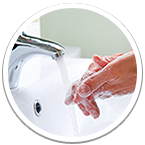MMRV, or MMR and varicella vaccine
The vaccine gives protection against measles, rubella, mumps and chickenpox.
Vaccine-preventable diseases
On this page
- To whom is the MMRV vaccine administered?
- Which vaccine is used and what does it contain?
- Dosage and schedule
- What are the contraindications and precautions associated with the vaccine?
- What are the benefits of the MMRV vaccine?
- What are the potential adverse effects of the MMRV vaccine?
- The history of the MMRV vaccine in the national vaccination programme
To whom is the MMRV vaccine administered?
The MMRV vaccine is offered free of charge in the national vaccination programme for those 6-year-olds who need both an MMR and a chickenpox vaccine.
If a child has had chickenpox, MMR alone is enough.
The MMRV vaccine purchased for the national programme is only used to vaccinate 6-year-old children.
Which vaccine is used and what does it contain?
The product used in the vaccination programme is called ProQuad.
- The MMRV vaccine contains live, attenuated measles, mumps, rubella and chickenpox viruses cultivated in chicken embryo and human cells.
- The auxiliary agents are sugar, sorbitol, gelatine, urea, salts, sodium glutamate, pH indicator dye and purified water.
- The vaccine does not contain significant amounts of egg protein (ovalbumin).
- The vaccine only contains traces of neomycin.
- The vaccine does not contain adjuvants.
Dosage and schedule
A single dose of the vaccine is 0.5 ml. It is administered at the age of 6 years.
In total, a child needs two doses of the MMR vaccine and two doses of the varicella vaccine.
In the national programme, the first MMR vaccine dose is administered at the age of 1 year, and the varicella dose at the age of 1.5 years.
The child receives a second dose of both vaccines when an MMRV 4-in-1 vaccine is administered at the age of 6 years.
The MMRV vaccine can also be given to a 6-year-old who has not had chickenpox or received any doses of the varicella vaccine. They will also need a second dose of the varicella vaccine at the age of 12.
What are the contraindications and precautions associated with the vaccine?
Always check the general precautions and contraindications associated with vaccines containing live attenuated pathogens.
Do not administer an MMRV vaccine to a person
- who has had an immediate severe allergic reaction, or anaphylaxis, following a previous vaccine dose, an MMR vaccine or a varicella vaccine
- whose immune system is significantly weakened due to an illness or its treatment
- who has had an anaphylactic reaction to neomycin or other excipients in the vaccine
- who is pregnant
- who is affected by rare hereditary fructose intolerance, as the vaccine contains sorbitol as a stabilizer.
The MMRV vaccine contains an MMR and a varicella vaccine. Consequently, the contraindications and precautions associated with both of these vaccines also apply to MMRV.
What are the benefits of the MMRV vaccine?
The vaccine gives protection against measles, rubella, mumps and chickenpox as well as their secondary diseases.
When using a 4-in-1 MMRV vaccine, a single injection can be given to a 6-year-old rather than two.
What are the potential adverse effects of the MMRV vaccine?
No symptoms occur in most healthy vaccine recipients.
One out of five experience local symptoms at the injection site, including pain, redness or swelling.
One out of twenty vaccine recipients develop a rash resembling chickenpox or measles. Usually they only have two to five blisters.
Generalised symptoms are rare. Approx. one out of five vaccine recipients develop a fever within 7 to 10 days after the vaccination.
The local reactions and generalised symptoms may be treated with fever and pain medications.
The MMRV vaccine contains an MMR and a varicella vaccine. This is why it has the adverse effects of both vaccines.
When the MMRV vaccine has been administered to children aged under 2 years as their first MMR and varicella vaccine, it has been more likely to cause fever and febrile convulsions than an MMR and a varicella vaccine administered separately.
This is why the first MMR and varicella vaccines are administered separately in the national programme. The vaccine given to 6-year-olds is an MMRV vaccine. In this age group, no difference has been observed in the incidence of fever or febrile convulsions.
History of the MMRV vaccine in the national vaccination programme
The vaccine was introduced in the national vaccination programme in autumn 2017 as the varicella vaccine was added to it.




